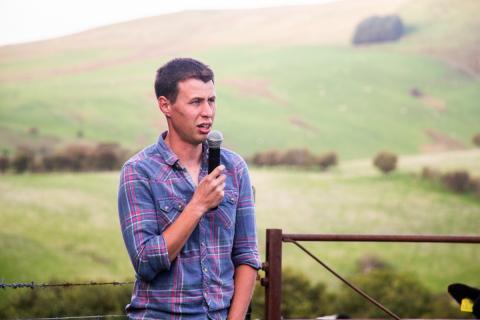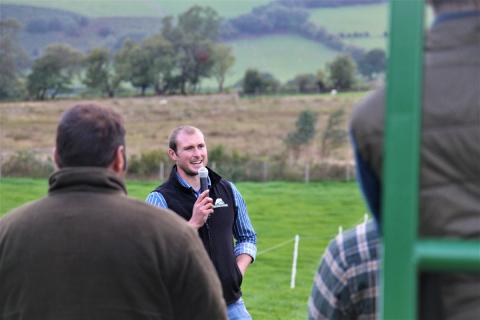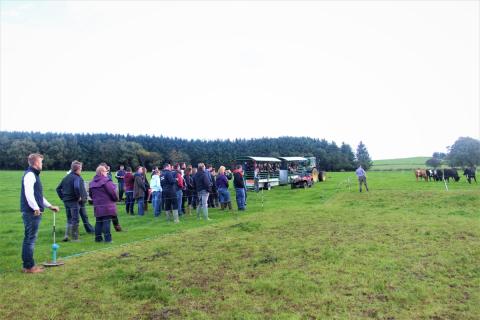12 September 2018
A Welsh livestock farmer has eased potential feed shortages with a policy of regularly measuring grass growth and analysing the figures with farm software to make informed decisions.
Rhidian Glyn runs a sheep and dairy heifer rearing enterprise on a rotational grazing system at Rhiwgriafol, a Farming Connect Demonstration Farm near Machynlleth.
During a Farming Connect Open Day at Rhiwgriafol, farmers heard how a combination of rotational grazing, measuring grass with a plate meter and using Farmax software to compare supply and demand has enabled the business to plan ahead, minimising the cost of nitrogen fertiliser and supplements.
Farm consultant James Daniel of Precision Grazing Ltd, who has been working with Mr Glyn to develop the business, said knowing the availability of feed on a farm allows farmers to make decisions early.
“By measuring his average farm cover, Rhidian had an early warning that he was going to run out of pasture and it gave him the opportunity to look at his options,’’ said Mr Daniel, a speaker at today’s event.
The options that Mr Glyn took were to wean early and put ewes on maintenance feed, graze a proportion of the area set aside for second cut silage, reduce target lamb sales weights and supplement heifers.
Now that pasture covers have recovered at Rhiwgriafol supplementary feeding has stopped and he will capitalise on the surplus grass by making a third cut of silage this week.
“Regular measuring of pasture covers will not change the weather but detecting a potential feed deficit early provides farmers with many more options on how to deal with it,’’ says Mr Daniel.
“For example, had Rhidian taken his second cut of silage as planned he would have worsened the feed deficit and needed to feed that dry matter back to the farm as bales or concentrates at twice to four times the cost.’’
Mr Glyn had planted 18 acres of swedes as winter feed for his ewes but this crop failed because of an absence of rain. To bridge the feed gap he replanted the field with a rape and ryegrass mix.
However the potential yield of this is estimated to be 50-60% lower than the planned swede crop so silage bales will be grazed in situ with the crop during the winter.
Rotational grazing, where a group of animals regularly move through a number of different fields in a planned order, is a simple way of increasing pasture growth and utilisation.
This approach can help to improve the quality of the pasture and is a far more profitable method of increasing production compared to renting more land, says Mr Daniel.
As a guide if the group of animals cannot graze a field within five to seven days, the field should be split in
half or into smaller sections, normally using electric fencing, he advises.
Rhidian rears dairy heifers on contract, taking them as weaned calves in July and returning them 16 months later in calf.
In the spring these heifers compete with the ewes and lambs for pasture so setting up a rotational grazing system provided Rhidian with the opportunity to increase pasture growth and minimise the area the heifers required.
Two fields totaling 32 acres were split into 16 paddocks with heifers spending 1.5-3 days in each paddock, depending on pasture growth rates.
Mr Glyn had been consistently grazing pasture down to 1400kg dry matter (DM)/ha but at that residual the grass plant was slow to recover and heifer growth rates reduced.
In May and June, when there was a surplus of pasture, he increased the target to 1700kgDM/ha.
“The pasture was far quicker to recover as there is enough leaf left to capture the sunlight and trigger photosynthesis,’’ said Mr Glyn.
Heifer intakes also increased resulting in average daily liveweight gains of 1.2kg over an eight-week period.
Following a poor start to the spring, maximising the heifers’ compensatory growth potential was essential to ensure they reached their target bulling weight.
The rotational grazing system has dramatically improved leys and Mr Glyn is planning to roll it out on another 32 acres for ewes and lambs next summer – he will tup 980 improved Welsh Mountain ewes and ewe lambs this autumn.
In reaction to this year’s difficult growing conditions, he is measuring grass more frequently. “I was not going out with the plate meter often enough, I now measure twice a month instead of once.
“Establishing what the farm position will be in a month’s time is important, measuring isn’t just about what the growth rates are at the time of measuring but about knowing what covers there are ahead.’’
The farm is currently facing an estimated shortage of 20 tonnes DM therefore the farm cover will be measured more regularly to determine if an application of nitrogen at 20-25kg/ha needs to be applied to third cut silage fields.
Ewe body condition score (BCS) at this stage in the year is critical as this will determine next year’s success, ewes should be 3-3.5 at tupping, requiring six weeks on good quality pasture to gain 1 BCS.
Mr Glyn’s ewes need to improve their condition by 0.5 BCS so he has split the flock in two, running a leader-follower system with the thinner ewes grazing one field ahead of the fit ewes.
“If the ewes are not going to achieve the target minimum of BCS 3 at tupping then delay tupping by a couple weeks, it is far easier for a ewe to gain weight now than it will be for it to do so in late pregnancy,’’ Mr Daniel recommends.
Lamb finishing on many farms has been made difficult by the dry conditions because it reduced feed quality and quantity, resulting in more lambs on farms at lighter weights.
Mr Daniel says farmers need to be careful that by aiming to finish the remaining lambs they are not compromising increasing their ewes BCS and building their farm cover for the winter.
“Regularly monitor lamb growth, consider sale options or use supplementary feed to ensure lambs leave the farm by early October and meet the required specification,’’ he says.
Putting in effort now to increase ewe condition, measure pasture and budget feed will pay off, he insisted.
“It is often difficult to get farmers to commit to measuring pasture and splitting fields to increase utilisation at this point in the year but in reality this is easier, cheaper and less stressful then carrying feed to ewes in Feburary and March.’’



